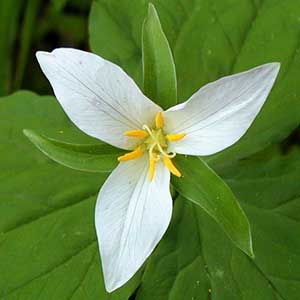Trillium ovatum
Trillium erectum
Pacific trillium, trillium, western trillium, western wake-robin, western white trillium, white or western trillium, white trillium
birthwort, red trillium, red wakerobin, stinking Benjamin, stinking willie, wake-robin
semierect to horizontal, short, stout, praemorse.
short, thick, praemorse.
1–2, round, 2–5 dm, ± slender, glabrous.
1–2, often with numerous offsets forming heavy clumps, round in cross section, 1.5–6 dm, ± robust, glabrous.
sessile, subsessile, or short-petiolate;
blade medium green, sometimes blotched and mottled, main veins prominent, ovate-rhombic, 7–12 × 5–20 cm, continuing to expand during anthesis, base rounded, apex acuminate.
sessile;
blade bright green, lacking dark pigmentation, major veins prominent, broadly rhombic to ovate-rhombic, 5–20 × 5–20 cm, about as broad as long, widest near middle, base attenuate, apex acuminate.
erect or nodding, odorless;
sepals spreading to horizontal, green, lanceolate to oblong-lanceolate, 15–50 × 6–20 mm, margins entire, apex acute;
petals erect-ascending, usually wide-spreading from base, exposing entire pistil, white or with pink or blush markings, lacking V-shaped markings, fading to rosy pink, purple, or dark red, veins not deeply engraved, ± linear to widely obovate, 1.5–7 ×1–4 cm, widest at or above middle, thin-textured, margins flat to undulate, apex acuminate;
stamens prominent, slightly recurved-spreading to straight, 10–18 mm;
filaments white, shorter than anthers, slender;
anthers yellow, 4–16 mm, slender, dehiscence latrorse-introrse;
ovary green or white, ovoid, 6-angled, 5–12 mm, attachment ± 3/4 ovary width;
stigmas recurved, barely connate basally, greenish white or white, linear, not lobed adaxially, 6–10 mm, uniformly thin;
pedicel erect to leaning, 2–6 cm.
erect, ascending, or proximal to but above bracts, odor fetid, like a wet dog;
perianth open, flat;
sepals flat to sulcate apically, green, often streaked or overlain with maroon, occasionally entirely dark maroon, lanceolate-acuminate, 10–50 mm, equaling petals, ± 1/2 petal width, texture leafy, margins entire, apex acuminate;
petals spreading, carried in same plane as sepals or ascending slightly, dark reddish brown, maroon, purple, or white, sometimes pale yellow, major adaxial veins prominent and appearing somewhat engraved, usually flat, lanceolate, ovate-lanceolate, or occasionally ovate, 1.5–5 × 1–3 cm, 2 times sepal width, widest near base, heavy-textured, apex acuminate;
stamens erect to slightly recurved, 5–15 mm;
filaments white, pinkish, or dark purple, ± equaling anthers, but variable within local populations, thin;
anthers erect or weakly recurving, dark maroon, grayish maroon, or yellowish, strongly yellow when pollen exposed, 5–12 mm, dehiscence introrse;
ovary dark purple to maroon, even in white-flowered forms, ovoid, elliptic to globose, 6-angled, angles forming very low ridges when fruit is ripe, 5–10 mm, broadly attached at base;
stigmas recurved, distinct, dark purple, not lobed adaxially, subulate, short, 3–7 mm, ca. 1/2 or less length of ovary at anthesis, fleshy;
pedicel straight, erect, or somewhat declined but not strongly recurved below bracts, 1–10+ cm.
baccate, green or white, ± odorless, broadly ovoid, obscurely winged, 1.2–2.8 × 0.7–1.9 cm, pulpy-moist.
dark maroon, weakly fragrant of fruit, ± globose to slightly pyramidal, 1–1.6 × 1–1.5 cm, juicy.
= 10.
= 10.
Trillium ovatum
Trillium erectum
Varieties 2 (2 in the flora).
(Discussion copyrighted by Flora of North America; reprinted with permission.)
Varieties 2 (2 in the flora).
(Discussion copyrighted by Flora of North America; reprinted with permission.)
1. Bracts sessile; petals lanceolate to obovate, 1.5–7 × 1–4 cm | var. ovatum |
1. Bracts distinctly short-petiolate; petals linear to linear-lanceolate, 0.5–2.4 × 0.2–0.6 cm | var. oettingeri |
1. Petals usually red, maroon, or dark purple. | var. erectum |
1. Petals white. | var. album |
- Local floras:
BC,
CA,
OR,
WA
- Local Web sites:
CalFlora,
CalPhotos,
Flora NW,
PNW Herbaria,
Turner Photog.
WildflowerSearch
iNaturalist (observations)
USDA Plants Database
- LBJ Wildflower Center
- SEINet
- Plants of the World Online
- Encyclopedia of Life
- Wikipedia
- Google Image Search


